
Days before, we started receiving emails and letters with many kind words of farewell. We felt that we were the personification of some people´s own wishes and dreams. Nice presents and little mementos were meant to sweeten our remote journey along the Silk Road. We even received a 30-year-old map of Afghanistan. Handing this valuable gift over to us was particularly difficult for this former globetrotter, but it came from the heart.
After our arrival in Delhi we experience these extremes four days long. Delhi is a city with 12 million inhabitants. Children beg on street corners, the traffic is unbearably loud and heavy, and the food is very spicy. We see mausoleums, merchants, colonial buildings and mosques, local markets, street traders, rickshaws, cows and pigs on the street. You can smell spices on every corner. It stinks of urine everywhere.
Two totally different districts distinguish this city. Old Delhi was the capital city of the Moguls from the 12th to 18th century, indicated by the impressive architecture. The major world faiths have left their influence. You also find narrow, twisting alleys of the old town full of small shops and markets, people sleeping in corners, cooking or following tourists begging for money. New Delhi with its broad avenues, large parks and modern office buildings looks quite austere compared to this.
Our city sightseeing tour takes us to the government district. Fifteen minutes after our visit in the Indian parliament, it is attacked and fourteen people are killed. From this day on, September 11 and December 13 are mentioned in the same sentence. For a second time world politics catches up with us. We knew at once that this criminal act would not spare our proceeding journey of further consequences.
Goa is a region characterized by the colonial influence and power of the Portuguese people. Mediterranean flair and white limestone Christian churches are evident of the era. We spend our Christmas time at the booths where local people sell Christmas decorations and crèches. This seems strange to us amongst palm trees.
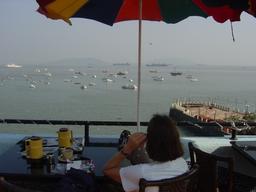 Waiting for the container |
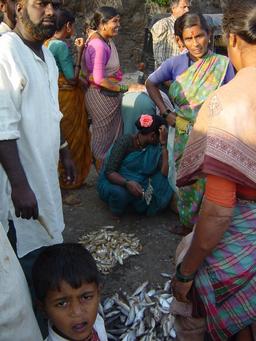 Fisch auction |
 Fort Janjira |
But now back to reality. Other globetrotters did not use the services of a clearing agent and needed four weeks to get their vehicle through customs. Initially we thought it was a joke but now we see things differently. Everything started pretty harmlessly: The officials doubted the authenticity of our ADAC issued customs documents ("carnet de passage"). They requested a written reconfirmation for the Indian automobile club, which then issued a certificate of non-objection to the Indian customs office. It took us two full days with the assistance of three clearing agent employees to fight our way through Indian (customs) bureaucracy. After countless cups of tea and as many visits to various customs officials we were especially "impressed" by the registrar´s office: A mountain of bundled files reaching to the ceiling just like at a recycling center. Unfortunately, pictures are not allowed. We saw not one single computer and obviously the Indian officials never heard of anything like official forms. What we liked most was going to the criminal investigations police. The police was supposed to confirm that we´re not being looked for by Interpol or that we are not state-acknowledged smugglers of drugs, gold or cars. Non-existent computers or a list with names was compensated by the deep, penetrating stare into our innocent faces.
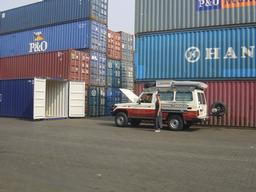 Customs port |
After two days of paper chasing we finally had the required 15 (!) signatures and were lucky not to have been poisoned by too much tea or lost under an avalanche of files in one of those nice spartan offices. And everything is done according to ISO 9002, as confirmed to us in writing on a 5-meter long sign at the entry gate. Well, even events like these are a part of getting to know a country. We now have the much longed-for customs stamp in the "carnet de passage," are approximately 750 lighter, partially spent as "acceleration money", and can now take off to Rajasthan to visit old caravan towns in the Thar desert. We have survived the first 50 kilometers from the port to the hotel without an accident, although the traffic is worse than anything we have ever seen during our journey in Cairo or Athens. Rear-view mirrors and blinkers are useless. The car´s most important part is the horn.
To be honest we were a little bit apprehensive. The political tensions between Pakistan and India led to West Rajasthan becoming a military deployment zone of the Indian army. And we don´t really want a side job working as war correspondents. Fortunately, the war cry of the politicians has given way to more diplomatic behavior so that we will drive to Rajasthan as planned. Let´s see how far we get. Quickly we take a farewell picture just before sunrise at the Gateway of India and then we try (!) to leave Mumbai taking the northern route.
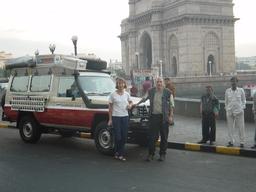 Gateway of India |
Maps and GPS only help us sometimes in the chaos of this 14-million-people metropolis and the traffic hardens us for tougher times. Finally we ask a taxi driver to guide us to the correct exit lane. According to GPS the distance is only approximately 800 km corresponding to a day trip under German standards. Not so in India - the country roads are mainly used by very old and totally overloaded trucks, mopeds, scooters, motor rickshaws, horse, ox and camel carts, working elephants, handcarts, pedestrians and surprisingly few cars. Amongst all this are the wild dogs, herds and the famous holy cows. And anything can show up at any time from any direction in front of your own hood. In the dark the entire scene feels like driving through a tunnel of horror, because some car drivers turn on their dim lights only before almost crashing into another vehicle.
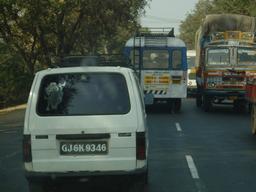 India mobile |
In all this chaos the traffic flows only because of the impressive readiness of all road users to show consideration for others and not to insist on one´s own rights. The people communicate with each other by gesturing out of the side windows and by honking before passing. Stoplights are always broken and nobody uses lights to indicate a turn-off to the left or right. The passenger beside the driver is responsible for assessing the oncoming traffic before passing, because the driver sits on the wrong side driving on the left. After three very exhausting days we finally make our first destination of Udaipur.
 Arrival in Rajasthan |
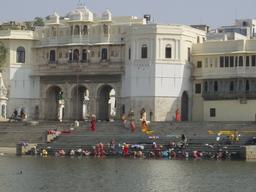 Udaipur |
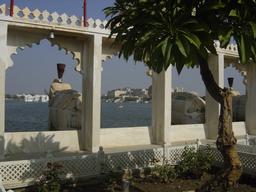 Udaipur Island Palace |
Due to the political situation we see few tourists in a city that counts amongst the most frequently visited in Rajasthan. On a sightseeing tour of the city palace and of the two island palaces on islands in the midst of the lake, we are very impressed by the splendor of the Maharajas and their long-ago luxurious lifestyle. We take our time to relax, to stroll in the old town and to see the surroundings before the journey continues.
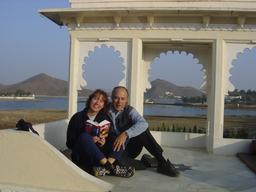 Relaxing |
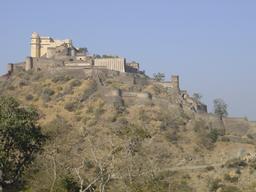 Fortress |
 On the way |
Before going to Mount Abu, we take a sightseeing tour of the Jain temple in Ranakpur. It seems that Shiva is smiling at us today. We have our first accident, but without mentionable damages. An Indian minibus scratches the sand plates while passing us. The bus is ripped open from front to back by the metal hooks. As usually done in these cases, each party pays for its own damaged vehicle.
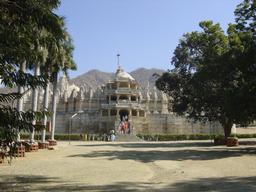 Ranakpur |
Mount Abu has an altitude of 1,200 meters. Because of the agreeable climate, it was the summer residence of the Maharajas and later on a popular British hill station. Due to its romantic atmosphere, idyllic location with Nakki lake, the castles and the mountains as a backdrop, Mount Abu is a favorite destination for newly weds whose families have decided that marriage has been considered appropriate. The days at Mount Abu are meant to help the newly weds get closer to each other with the hope that the parents had made the right choice. Even today, the arranged couple has an average of three months to get to know each other (or to pull the "emergency brake" which certainly requires a good explanation). Mount Abu is also known for its Dilwara Jain Temple, which is a pilgrim center. It consists of five separate temples, all built of white, almost transparent marble.
Our camp is quickly set up in the park of the former summer palace of a Maharaja. The current owner initially hesitates, but can be convinced of our unusual plan.
The following city sightseeing tour is very interesting - we watch the hustle and bustle of the newly weds under watchful eye of their families. We decide to try our luck again at an Internet cafe. The atmosphere is not very inviting - an old, sick man lies on a plank bed beside the computer and a big rat is running around. The connection breaks down every few minutes. We soon give up in frustration.
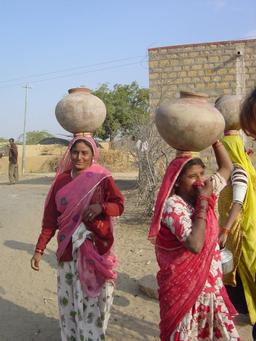 Women getting water |
The tour´s highlight is our visit to the neighboring village. Forty families live here as they did 100 years ago - without roads, electricity or the other comforts of modern life. However getting to the village is difficult. To the left and the right of the road are soldiers on tanks, trained for war and armed to the teeth. An army officer refuses to let us pass. He is not even willing to discuss the matter with us! Fearful of a state-enacted halt of our activities, we decide with heavy hearts to do without the certainly spectacular pictures for our website. All we can do is take the direct route over the high sand dunes and avoid the prohibited zone. We made it thanks to our experience in the Sahara and to reduced tire pressure.
 Sand dunes |
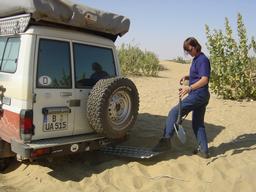 Stuck |
Upon arrival in Neemb ki Dhani, we visit a family whose baby was born on the same day. In the inner circle of five clay huts the grandfather is working on a name for the baby boy - according to ritual tradition. The parents have no say in this matter and we are able to witness the festive moment when the parents are informed of the boy´s name. The father may only see the mother and child nine days after the baby was born, by the way. For some time we remain in the hut and politely drink the home made liquor discussing the political situation and worries of the desert people who have lost their accustomed freedom due to the military presence. At night is curfew and the camel tours in the desert, which normally take a few days, are also prohibited.
The house-building technique of the Jhoopa is very interesting. A layered mixture of clay, stone and dried cow dung form the wall of the hut topped by a straw roof. The insulation against heat is fantastic and the evaporating cow dung keeps away the mosquitoes.
 Basic wall |
 Roof construction |
Our eventful day ends with a typical, beautiful sundown. In the evening we are guests at a spontaneous family party with folklore music and dance. The Indian women have fun dressing Ute in a sari and putting the typical bindi on her forehead.
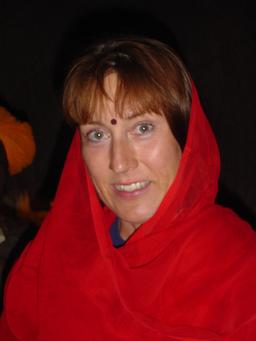 Ute in a sari |
India has many faces to discover if you do not go to the usual tourist traps.
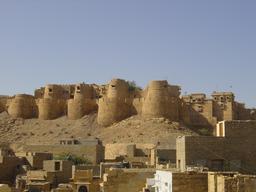 Fort |
 Havelis |
Jaisalmer is flooded with soldiers. Numerous trucks, jeeps and motorcycles are parked on the outskirts of the city. Because of its strategic location (60 km from the Pakistani border) Jaisalmer has been a military base for many years and due to the current, politically unstable situation it is naturally very busy.
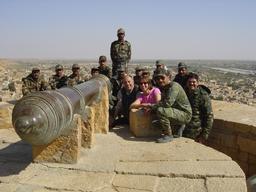 India olive |
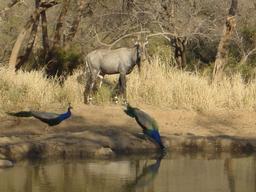 Watering hole |
A highlight even for non-ornithologists: the Keoladeo National Park, one of the world´s most significant wild bird protection areas with 370 bird species and over 100 species of migratory bird. We are able to observe the Siberian crane, which is threatened by extinction, and various other aquatic birds up close. Not too far from the road we discover two pythons coming out of their caves to shed their skins.
The Taj Mahal was completed in 1653 after 22 years of construction. A Mogul ruler dedicated this monument to his deceased wife. The marble mausoleum is located in a huge park with two mosques. Everything is symmetrically built and the marble facades are decorated with various ornaments. In its entirety a very impressive monument with an ambience of dignity.
 Taj Mahal |
 Changing the tire |
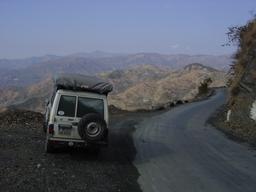 Destination Himalayas |
Today we want to explain how we gather information for our website and keep in touch with the outside world. For many years Andreas has been engaged in research and development in the context of his employment with a subsidiary of Deutsche Telekom. His idea to create a website was initially heavily discussed between the two of us, because we knew from the start that this would involve a lot of work and require extra equipment. We were sure that the largest part of our itinerary would be in "IT-no man´s land". However, we were willing to give it a try. In the end we were both convinced that our friends and relatives should have the chance to take part in our travel experiences in the quickest way possible.
How does this work in practice? We found a comrade-in-arms: Thom Brenner and his small high-tech company bit~side in Berlin. He and his team are very involved in developing and testing new online solutions. Though our website is not a "multimedia fireworks" of online design (flash, audio, etc.). The real innovation is the small, rather unspectacular route map - freely navigable per mouse - on which we directly mark our exact location by sending an SMS via satellite mobile phone.
The satellite phone is also brand new on the market and not much bigger than a normal mobile phone. Phone calls are transmitted via satellite or traditional mobile networks. All you need is a phone number and the mobile box that you know from your mobile phone at home. By the way - speech quality is absolutely fantastic and the cost is relatively low (mobile phone about 1,100 euro, no basic fee and the connection charge per minute about 1 euro). The satellite is owned by the United Arab Emirates (www.thuraya.com) who also provides the service. We use a digital camera for our online reports and a laptop to store data and write our copy in the most unusual places (in the roof-top tent or - if it´s very cold - in bed, the laptop comes in handy as a hot-water bottle)
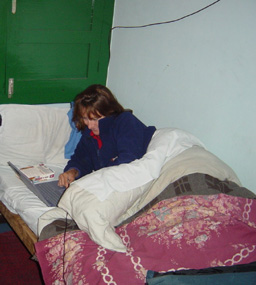 Online with numb fingers |
Until now we have collected more than 1,500 pictures, which we burn onto a CD from time to time for security reasons. We transmit data primarily whenever we´re in an Internet café, which involves lots of patience and money because of unstable transmission lines and an obsolete infrastructure. In the meantime, we have made quite a few amazing sightseeing tours of Indian Internet cafés. Continuous down outs or real catacombs with rats are just some examples that have to be mentioned.
 Ruins in the Net |
But we do this because we enjoy it; we can see from the number of visitors on our website that there is a strong interest in reading our reports.
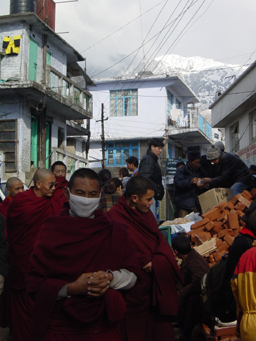 Market in McLeodGanj |
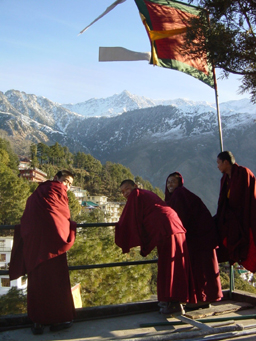 Monks in the temple |
This time the reception is less friendly: A drunken Tibetan is angry because we accidentally parked our land cruiser on his piece of land. Well, you can´t always meet nice people! It takes us a long time to find a new parking spot in the darkness. Either there is no place for all the buildings or the space is too steep. Parking at a 10-degree incline is kind of scary: We park the car in 4L(ow) gear with the wheels locked. We´ll have to see if we can get away from this spot because the snow, hail and rain has turned the street into a slippery slope. Also the town has had no electricity for a day (and a very chilly night) due to the storm. No light and no heat make sleeping in the car impossible because we could roll out of the car at this angle. Two nice men from Kashmir take us to their little guesthouse and we get first-hand information about what the Kashmir conflict personally means to many people. They are refugees in their own country and get much less notice than the Tibetans. Our first walk takes us to the Namgyal Monastery and its prayer hall where the Dalai Lama occasionally holds religious ceremonies. A few days later - on the 13th of February - we take part in the Tibetan New Year´s celebrations. This New Year´s Eve feels like home with all the decorations and watching the obligatory fireworks. Monks and nuns wish us a happy new year and give us a nice little present of a lucky charm made out of wax.
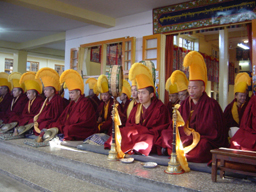 Tibetan New Year´s celebrations |
On an absolutely beautiful sunny day we start our first easy tour in the surrounding mountains with an altitude of over 800 meters. Unfortunately we have to return 300 meters before reaching the peak because the snow surface is not stable enough. We certainly do not want to brusquely terminate our journey at this point. Our host from Kashmir wants to accompany us in his only shoes (slippers!). We cannot believe our eyes and make him wear Ute´s sports shoes.
After five quite eventful days we leave McLeodGanj and head to Spiti, a former kingdom in the Himalayas. We still don´t know if we will definitely get there, because the only access road has been closed for two weeks due to heavy snowfall. Let´s see how far we get.
Manali (2,000 meters above sea level) is snowed in too. The locals haven´t seen this much snow in eight years. The four-wheel drive is put to the test and we pass other vehicles millimeter by millimeter. Twice we are stuck in a snow hole ourselves and all we can do is shovel ourselves out. We´re using the sand plates as snow plates now to free us from this hopeless situation. We are dripping with sweat!
We start asking for cross-country skis. The people look at us as if we were aliens when we describe what we want. We explain cross-country ski bindings and skins for climbing the mountains. After a few attempts we get what we are looking for: We find some very old cross-country skis in an old barn and quickly sand the rust off with sand paper. We are lucky to find some old skins and ski boots that almost (!) fit. Let´s go! We ignore the few blisters on our ankles.
 Wich way to the peak? |
 Skiing in the Solang Valley |
Due to the fresh snow there is great danger of an avalanche. Therefore we have to plan our trails very carefully. Unfortunately we left our avalanche search equipment in a warm and dry place in Berlin. The Alpine Club will hopefully forgive us for this negligence. Coming back from our first ski tour to our car, there is a big surprise! Indian people have decorated our bumper with a long garland of flowers to welcome us and to wish us good luck. What a nice gesture!
As usual, the distance of 400 kilometers does not look far on the map. It takes us however three full days to get there and again puts a strain on our nerves. This time we primarily use side streets along the mountain range of the Himalayas. Often the streets are so small that they are not even marked on our map and the GPS. Then we just have to ask someone. In the meantime we have developed a real questioning system because the locals usually send us in all directions: When we get at least three identical answers to our question within approximately 200 meters, we take that direction. The people rarely speak English and most of them cannot read, let alone understand a map. This takes up precious time so that we must drive after dark, which was not really planned. Suddenly we find ourselves in 80 cm deep water and then just as quickly the road disappears. A motor-rickshaw driver in front of us isn´t as lucky as we are. His vehicle sinks into a mixture of mud and water. Fortunately we do find a lodge in the darkness. The next day we first have to ask where we are.
Even though, the scenery we see on this trip is very impressive. The temperature quickly reaches the usual 30 degrees. Instead of the heating, we turn on our air-conditioning. We are still enjoying discovering new things. We turn off into a dried-up river valley and arrive at a very traditional village of huts after driving a few kilometers over "sticks and stones"
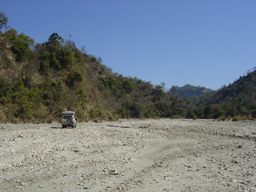 Turn-off into a valley |
The inhabitants quickly pull out a wooden bed from their hut. We take a seat and the whole village community observes us wordlessly. At our efforts to communicate we are met with an uncomprehending smile. Still, the people offer us hot, sweetened milk that is a brand new experience in this heat. The uneasy situation is saved thanks to our small photo album with pictures from our home country and family members. Suddenly the ice breaks: Pictures can obviously express more than words. In the end we even have the courage to make a picture of the whole group.
 Village community |
We continue our journey and arrive at the Rajaji National Park, which is situated in the midst of beautiful scenery. We take a very strenuous off-road tour. Only the animals seem to have gone on vacation or maybe the park´s inhabitants really aren´t vegetarians after all?
 Wäsche waschenWashing clothes |
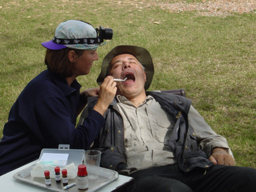 Bush dentist |
We definitely recommend a visit to the Corbett National Park. In an area of almost 1,400 square kilometers you can watch tigers, wild elephants, Samba deer, eagles, owls, huge crocodiles, more than 600 species of bird and various other animals. After you´ve worked your way through the Indian bureaucracy you will experience different scenery and vegetation beyond the entrance gate to the park. There are alternating bush and mountain landscapes, then rivers and widespread grassland. The most interesting observations can be made at the first light of day and shortly before sundown. We stay in the park for a few days and take thrilling day trips with an obligatory tour guide. Only once do we get too close to an elephant herd.
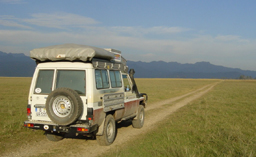 National Park landscapes |
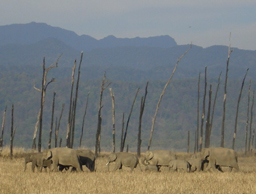 Elephant herd |
An elephant leaves his herd and runs with enormous speed and loudly trumpeting directly for our land cruiser. After a moment of shock we flee by putting the car into reverse. We have never before gone in reverse for so long and so fast. The elephant runs a 100-meter stretch stopping 5 meters from our land cruiser. Beside us our guide´s face is pale too. After this adventure we leave this beautiful national park with a heavy heart and continue in the direction of Nainital, where it´s rumored we may finally find a bank that changes traveler´s checks into rupees.
 Himalaya |
We follow this pilgrim route in a northerly direction as long as possible by vehicle. The rainfall of the past few days have led to various landslides, which forces us to return shortly before reaching our destination, the Narayan Swami Ashram near Sosa (2,440 meters). At this point the trail ends at a rock face. We still think that the tour to the China-Nepal border area was worth the trip.
We´ve often asked ourselves: How can this state function at all? India is the world´s largest democracy with more than 1 billion inhabitants. There is no common language understood by all Indians. Although English is the official language in India, the people communicate in fifteen officially approved languages. Almost fifty percent of all Indians are illiterate and 34 percent of the people are younger than fifteen. Child labor and poverty exist everywhere. Only four percent of Indians pay taxes. The big cities are very dirty and the pollution is unbearable. In Delhi you inhale as much dirt each day as if you´d been smoking fifteen cigarettes. The outskirts of the city is one big slum. The traffic is a catastrophe and you would have to drive here yourself to imagine such chaos. The bureaucracy and the relative slowness of the bank, tourism and state employees give us the impression that they would rather not give us any help or information or to avoid some work send us to the wrong office. India is a melting pot of all world faiths. More Moslems live here than in all Arab countries put together. You only get a small idea of the hidden tensions while observing the religious unrest currently in Gujarat.
We tried to understand these problems by talking to the locals. In these conversations we never noticed that Indians were unsatisfied with their personal life. They do not envy possessions or the wealth of others. Everybody accepts his own fate and tries to do the best for himself and his family. Never ever did we hear a complaint about someone´s personal circumstances. The Indians seem to be a happy people. Certainly we saw more laughing and smiling people on the streets here than in Germany.
The experience we made in India has been very valuable. We will surely come back to India as "normal" tourists one day. There are so many more things to discover. We love to remember our time in India and look forward to our journey to Nepal. Regardless of the beauty of nature, we will certainly be facing problems in Nepal too. We will have to see what will happen.
 Namaste India |